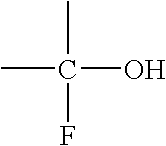Insulated perfluoropolyether alkyl alcohols
- Summary
- Abstract
- Description
- Claims
- Application Information
AI Technical Summary
Benefits of technology
Problems solved by technology
Method used
Image
Examples
example 1
Preparation of F[CF(CF3)CF2O]zCF(CF3)CF2CH2CH2I (“Compound 1”)
[0066] A high-pressure 1800-psig (12.5 MPa), 304 ss, 0.25 inch (0.64 cm) female National Pipe Thread (NPT) single ended 150-mL HOKE Cylinder (Peacock, Edmonton, AB) fitted with a 400 psig (2.86 MPa) ss-gauge, SWAGELOK 0.25 inch (0.64 cm) male NPT x female NPT street-tee, and a 316 ss, straight 0.25 inch (0.64 cm) male NPT x SWAGELOK needle valve was charged with poly-hexafluoropropylene oxide primary iodide (87 g, 64.7 mmol) and degassed under vacuum at 25° C. Ethylene (3.37 g, 129.6 mmol) was then transferred to the same cylinder under static vacuum at −196° C. and then slowly warmed to 25° C., when a pressure of 238 psig, 1.74 MPa was measured). The contents were heated to 220-250° C. for 24 h. The pressure reached as high as 300 psig (2.17 MPa) during the reaction and around 150 psig (1.14 MPa) when cooled after 24 h to 25° C. After the reaction was completed, the excess ethylene was vacuum-stripped to give a light ta...
example 2
Preparation of F[CF(CF3)CF2O]zCF(CF3)CF2CH2CH2OH (“Compound 2”)
[0068] To a 250-mL three-necked flask was added 50 mL of 20% oleum. The flask was fitted with a reflux condenser. The reaction apparatus was flushed with nitrogen. Compound 1 (10 g, prepared as above was added slowly to the oleum using a separatory fumnel (a syringe was an alternative) over the period of an hour; the reaction darkened to a black color. The temperature was maintained at about 90° C. The black reaction mixture was then hydrolyzed by pouring the acid mixture into 125 mL of 1.5% sodium sulfite solution (Na2SO3(aq), 15.161 g in 1 L of water) in an ice bath over a 10-minute period. The color of the reaction mass became a clear light yellow. Ethanol (200 mL) was added after the aqueous sulfite solution and the alcoholic mixture was refluxed at 100° C. and the end of the hydrolysis reaction was detected by GC / MS. The reaction took up to 10 or more hours. As the alcohol (Compound 2) forms it separates from the a...
example 3
Preparation of F[CF(CF3)CF2O]nCF(CF3)CF2CH2CHICH2OH (“Compound 3”, using AIBN)
[0070] Poly-hexafluoropropylene primary iodide (30.4 g, 22.6 mmol), allyl alcohol (1.75 g, 30.2 mmol), and 2,2′-azobis (isobutyronitrile) (AIBN, 50 mg, 0.43 mmol) were heated under positive nitrogen pressure for 86 h at 90° C. in a 250-mL round-bottomed flask fitted with a reflux condenser, thermometer, and magnetic stirrer. The reaction was monitored every 24 h by GC / MS. If the reaction had not progress any noticeable amount, additional AIBN (50 mg) was added. When the reaction was complete as evidenced by the GC / MS, the product was washed in a separatory funnel with three 20-mL portions of acetone. The product (Compound 3) was a brown oil (27.1 g, 85% yield).
[0071] The spectroscopic (nuclear magnetic resonance and mass spectrometry) evidence was consistent with the characteristics of the desired compound.
[0072] Example 3 demonstrates the conversion of the —CF2-I terminal group into the —CF2CH2CHICH2OH...
PUM
| Property | Measurement | Unit |
|---|---|---|
| Temperature | aaaaa | aaaaa |
| Temperature | aaaaa | aaaaa |
| Temperature | aaaaa | aaaaa |
Abstract
Description
Claims
Application Information
 Login to View More
Login to View More - R&D
- Intellectual Property
- Life Sciences
- Materials
- Tech Scout
- Unparalleled Data Quality
- Higher Quality Content
- 60% Fewer Hallucinations
Browse by: Latest US Patents, China's latest patents, Technical Efficacy Thesaurus, Application Domain, Technology Topic, Popular Technical Reports.
© 2025 PatSnap. All rights reserved.Legal|Privacy policy|Modern Slavery Act Transparency Statement|Sitemap|About US| Contact US: help@patsnap.com

